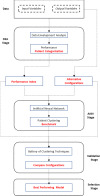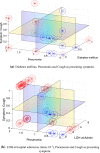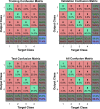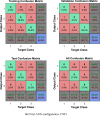A hybrid data envelopment analysis-artificial neural network prediction model for COVID-19 severity in transplant recipients
- PMID: 33907345
- PMCID: PMC8062617
- DOI: 10.1007/s10462-021-10008-0
A hybrid data envelopment analysis-artificial neural network prediction model for COVID-19 severity in transplant recipients
Abstract
In an overwhelming demand scenario, such as the SARS-CoV-2 pandemic, pressure over health systems may outburst their predicted capacity to deal with such extreme situations. Therefore, in order to successfully face a health emergency, scientific evidence and validated models are needed to provide real-time information that could be applied by any health center, especially for high-risk populations, such as transplant recipients. We have developed a hybrid prediction model whose accuracy relative to several alternative configurations has been validated through a battery of clustering techniques. Using hospital admission data from a cohort of hospitalized transplant patients, our hybrid Data Envelopment Analysis (DEA)-Artificial Neural Network (ANN) model extrapolates the progression towards severe COVID-19 disease with an accuracy of 96.3%, outperforming any competing model, such as logistic regression (65.5%) and random forest (44.8%). In this regard, DEA-ANN allows us to categorize the evolution of patients through the values of the analyses performed at hospital admission. Our prediction model may help guiding COVID-19 management through the identification of key predictors that permit a sustainable management of resources in a patient-centered model.
Supplementary information: The online version contains supplementary material available at 10.1007/s10462-021-10008-0.
Keywords: Artificial neural network; COVID-19; Data envelopment analysis; Kidney transplant; Logistic regression; Random forest.
© The Author(s) 2021.
Conflict of interest statement
Conflict of interestThe authors declare no competing interests.
Figures








Similar articles
-
How to improve the future efficiency of Covid-19 treatment centers? A hybrid framework combining artificial neural network and congestion approach of data envelopment analysis.Comput Ind Eng. 2023 Feb;176:108933. doi: 10.1016/j.cie.2022.108933. Epub 2022 Dec 29. Comput Ind Eng. 2023. PMID: 36594043 Free PMC article.
-
Safety and Efficacy of Imatinib for Hospitalized Adults with COVID-19: A structured summary of a study protocol for a randomised controlled trial.Trials. 2020 Oct 28;21(1):897. doi: 10.1186/s13063-020-04819-9. Trials. 2020. PMID: 33115543 Free PMC article.
-
Data-Driven Prediction for COVID-19 Severity in Hospitalized Patients.Int J Environ Res Public Health. 2022 Mar 3;19(5):2958. doi: 10.3390/ijerph19052958. Int J Environ Res Public Health. 2022. PMID: 35270653 Free PMC article.
-
Predictors of disease severity and outcome of hospitalized renal transplant recipients with COVID-19 infection: a systematic review of a globally representative sample.Rom J Intern Med. 2021 Mar 5;59(1):10-42. doi: 10.2478/rjim-2020-0034. Print 2021 Mar 1. Rom J Intern Med. 2021. PMID: 33155999
-
The Impact of SARS-CoV-2 Infection, and Application of Immunosuppressive Agents in Kidney Transplant Recipients Suffering from COVID-19.Pharmaceuticals (Basel). 2021 Oct 17;14(10):1054. doi: 10.3390/ph14101054. Pharmaceuticals (Basel). 2021. PMID: 34681278 Free PMC article. Review.
Cited by
-
The Application of Data Envelopment Analysis to Emergency Departments and Management of Emergency Conditions: A Narrative Review.Healthcare (Basel). 2023 Sep 14;11(18):2541. doi: 10.3390/healthcare11182541. Healthcare (Basel). 2023. PMID: 37761738 Free PMC article. Review.
-
The efficiency evaluation of traditional Chinese medicine hospitals by data envelopment analysis in Zhengzhou, China.Front Public Health. 2024 Sep 4;12:1445766. doi: 10.3389/fpubh.2024.1445766. eCollection 2024. Front Public Health. 2024. PMID: 39296838 Free PMC article.
-
The applications of MCDM methods in COVID-19 pandemic: A state of the art review.Appl Soft Comput. 2022 Sep;126:109238. doi: 10.1016/j.asoc.2022.109238. Epub 2022 Jun 30. Appl Soft Comput. 2022. PMID: 35795407 Free PMC article. Review.
References
LinkOut - more resources
Full Text Sources
Miscellaneous
